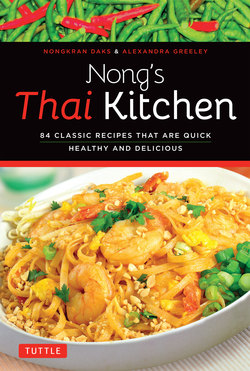Читать книгу Nong's Thai Kitchen - Nongkran Daks - Страница 10
ОглавлениеBasic Methods and Techniques
While items like pandan juice and tamarind juice may be available commercially, using fresh homemade versions makes for a huge difference in flavor.
Pandan Juice
Nam Bai Toey
The juice of pandan (also known as pandanus) leaves is the “vanilla” of Thai cuisine. This ingredient is used in desserts, and, on occasion, with rice and in drinks. It has a wonderfully distinctive flavor and a fragrance so pleasing that some taxi drivers keep it in the back of their cabs. You may also encounter the scent of pandan in the bathrooms of some Thai establishments and in flower arrangements. Commercially available pandan juice may also be used, but it doesn’t compare with the flavor and aroma that the freshly made juice adds to dishes. Look for the leaves fresh or frozen in Asian supermarkets or dried from online markets. You can also purchase pandan leaf extract from Asian markets and on the internet.
Preparation time: 5 MINUTES
Makes 1/2 CUP (125 ML)
1 cup (130 g) chopped pandan leaves
1/2 cup (125 ml) water
Combine pandan leaves and water in a blender and purée until smooth. Drain through a sieve or squeeze through a cheesecloth into a container. Discard the leaves. Any leftover liquid should be frozen.
Tamarind Juice
Nam Makham
Tamarind paste is available in 8-oz (225-g) and 1-lb (450-g) packages in most Asian markets. This juice can be refrigerated for up to a week; after that, it may turn rancid.
Preparation time: 1 MINUTE, PLUS 20 MINUTES FOR SOAKING
Makes 1 CUP (250 ML)
Break off 1/3 cup (100 g) tamarind paste and place in a nonreactive bowl. Add 1 cup (250 ml) warm water. Let the tamarind soak for 30 minutes, then squeeze and knead the paste until it dissolves. Strain out seeds and fiber, and either use or store the resulting liquid.
How to Make Toasted Rice
1 For best flavor, rice should be freshly toasted. If you only cook Thai food occasionally, just make a little at a time so the toasted rice doesn’t lose its fragrance. As I cook Thai food frequently, I make a cup at a time and keep the unused portion in a tightly closed jar in the refrigerator.
2 Dry-fry uncooked white sticky rice in a wok or skillet over low heat, stirring frequently. To enhance the fragrance, add 4 to 5 slices of galangal or lemongrass. Keep frying until the grains are deep golden-brown, about 13 minutes.
3 Let toasted rice cool, and then grind in a spice grinder until it resembles cornmeal.
How to Toast Seeds
Spread the seeds in a layer on a clean baking sheet and toast them in a 350°F (175°C) oven, stirring frequently, for 5 minutes or until fragrant and lightly browned. It may be easier to toast the amount needed in a dry skillet over low heat, stirring frequently, until the seeds are toasted. This may take just a few minutes depending on the type of seed and its size. You can also microwave seeds on high heat for 2 minutes, stirring after 1 minute to be sure they toast evenly.
How to Toast Coconut
1 Coconut is toasted much as seeds are. Spread coconut flakes in a shallow baking pan. Toast in a 350°F (175°C) oven for 15 to 20 minutes or until lightly browned.
2 If you only need a small amount, you can toast coconut in a frying pan over low heat, stirring frequently until lightly browned, for 7 to 10 minutes. You can also microwave on high for 3 minutes, stirring every minute.
How to Roll-Cut Vegetables
Long, cylindrical vegetables like carrots, zucchini, daikon radish, Asian eggplants, or Chinese okra are best suited for roll-cutting. I particularly recommend this technique if the vegetables are to be pickled or stir-fried. Asian cooks often roll-cut vegetables in order to expose more surface area to the heat. Roll-cut shapes are also attractive, making for a nice presentation.
1 Wash and peel the vegetable.
2 Lay the vegetable on a cutting board. Position your knife at a 45-degree angle, maintaining a firm grip on the vegetable. With a diagonal cut, remove the thick end and discard. Then roll the vegetable a quarter turn toward you and make another diagonal cut. Repeat until you reach the end. Discard the last piece.
3 This process produces multi-faceted pieces that gain maximum flavor when stir-fried or pickled.
